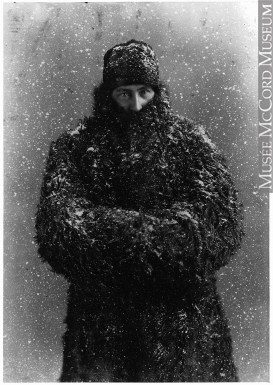I had the chance yesterday to visit Notman: Visionary Photographer at the Canadian Museum of History. The large exhibit covers the photographic output of William Notman (1826–1891) who opened numerous studios in Canada and the U.S. during the Victorian period. The Scottish-born Notman moved to Montreal in 1856 and used the city as a base to develop a thriving business built on studio portraiture, documentary photography and technical innovation.
A.H. Buxton
Montreal, QC, 1887
Wm. Notman & Son
1887, 19th century
Silver salts on paper mounted on paper – Albumen process
17 x 12 cm
Purchase from Associated Screen News Ltd.
II-82621.1
© McCord Museum
I took in Victorian Giants: The Birth of Art Photography at the National Portrait Gallery when I was in London in May, so I wasn’t sure that I was ready for yet another Victorian photographer. I found that the pictures by the photographers on display—Julia Margaret Cameron, Lewis Carroll, Clementina Hawarden and Oscar Rejlander—were often sentimental, somewhat repetitive and already very well-known. (I may need to work on my attitude, given that there is a Rejlander exhibit now on at the National Gallery of Canada and I will likely go to see it…)
I’m glad to say that I found Notman’s work quite interesting. I was impressed both by his business acumen and also by his pursuit of new technology to improve the way he made his images (an early adopter of artificial light in the studio and a pioneer in the creation of snow and ice effects, as well as an early master of creating large-scale composite images) and to get them in front of audiences (a contributor to the half-tone printing process, a consummate merchandiser and marketer, and someone who fully used the work of studio teams to make and process pictures). I found many of his portraits to be almost modern in their approach, with a directness that was rarely sentimental.
I also appreciated Notman’s documentary work that often portrayed scenes with which I am familiar—Montreal, Ottawa, Toronto and Niagara Falls. Many of these photographs were no doubt made to help market a young Canada to a European audience, but they serve as an impressive record of what life looked like in this country in the late 1800s. It is also very helpful that Notman employed an organized system to identify every one of the images he took and that some 450,000 of his images have been catalogued and preserved in Montreal’s McCord Museum.
